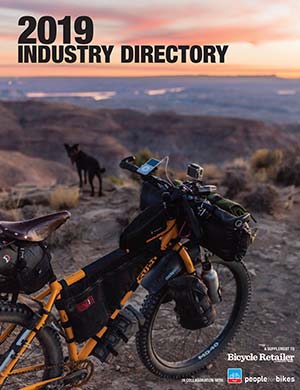A version of this article ran in the May issue of Bicycle Retailer & Industry News.
DANA POINT, Calif. (BRAIN) — The closing session at this year’s Bicycle Leadership Conference was not the flashiest or the best attended. But it probably was the most sobering 60 minutes of the two-day conference.
“It was a real eye-opener,” said Claudia Wasko, the general manager of Bosch’s North American e-bike business, after the session.
Session moderator Larry Pizzi said he sensed the interest in the audience.
“I can tell you, from the stage I was looking out and I saw people standing up so they could take pictures of the slides,” he said after the session.
So what was so enthralling?
There wasn’t a lot of new information. Instead it was a fresh overview of federal e-bike regulations, some of which go back two decades. The review highlighted the steep penalties that could come from non-compliance — bankruptcy-inducing fines and other regulator actions that could set back the entire industry.
“That was a rather sobering discussion for probably 50% of the people in that room,” said an industry attorney who sat in on the session.
The presenters were Erika Z. Jones, an attorney who recently prepared a memo for PeopleForBikes members on relevant regulations; and Erik Pritchard, who is the president and CEO of the Motorcycle Industry Council and also leads several trade groups for the powersports, OHRV and speciality vehicle industries.
Is that bike an electric bicycle?
Jones, a partner at the Washington, DC, law firm Mayer Brown, noted that in 2002 regulators drew a distinction between electric motorcycles and electric bikes. The 2002 regulation put most e-bikes under the purview of the Consumer Product Safety Commission, which regulates bicycles. Electric motorcycles are regulated by the National Highway Transportation Safety Administration.
It’s a key distinction, Jones said, because NHTSA requires vehicles to meet higher standards on lighting, brake performance, tire performance and other items, and has a recall system separate from the CPSC recall process familiar to many in the bike industry.
Perhaps most importantly, selling a product that doesn’t comply with either federal body's rules is very expensive: The CPSC can impose civil penalties of up to $120,000 per non-compliant bike, to a maximum of $17.15 million. NHTSA can impose penalties of up to $24,000 per noncompliant motorcycle, to a maximum penalty of $122.1 million. Both can also impose mandatory recalls of non-compliant products.
A bike that’s not really a bike or an electric motorcycle that doesn’t meet electric motorcycle requirements could trigger the penalties.
So where is that dividing line between an e-bike and an electric motorcycle?
A bike is a two-wheeled vehicle that is solely human-powered or has pedals and an electric motor of less than 750 watts (1 horsepower), and which can be powered solely by the motor to less than 20 mph (for a 170-pound rider on flat ground).
Vehicles that exceed that can be subject to NHTSA regulations. NHTSA regulations do not apply to offroad vehicles, but just declaring a vehicle as an off-roader is not sufficient. Vehicles that can and are used on public roads, even if they are marketed as offroad vehicles, can become subject to NHTSA regulations.
Speed governors on e-bikes can keep a bike within the 20mph cut-off. But if the governors are easily defeated by consumers, NHTSA could exert its authority. Manufacturers who become aware that their bikes can be modified to exceed the limit could be held liable, she said.
‘Don’t be the hoverboard’
Pritchard shared how the powersport industry has developed rider training and education programs to keep ahead of possible regulations following a costly experience in the 1980s.
The industry suffered a blow in that decade when regulators became alarmed at injuries and deaths associated with three-wheeled ATVs. While some dispute the accident statistics, the incidents became increasingly public and regulators took notice. In 1988, manufacturers signed a consent decree with NHTSA effectively taking three-wheelers off the market. Manufacturers also agreed to fund a $100 million ATV safety program.
Pritchard said a few highly visible e-bike accidents could catch the attention of federal regulators. He urged the bike industry to get ahead of the issue with rider education programs. In powersports, manufacturers subsidize rider education, including incentivizing new customers with cash to attend safety classes. The incentives ensure a significant percentage of users receive the training.
With millions of riders hopping on e-bikes without knowing the rules and etiquette for their use, more accidents are inevitable. “Some celebrity is going to get hurt, or some kid, and it’s better to respond as an industry than a brand,” Pritchard said.
E-bike batteries are also a major safety concern, Pritchard said, pointing to the once-thriving hoverboard industry. After a series of fires in 2015 and 2016, the CPSC cracked down hard. It essentially banned the sale of any hoverboards that did not meet an Underwriters Laboratories safety standard. But here’s the rub — the standard didn’t even exist until early 2016, after millions of hoverboards were already on the market.
The CPSC stopped short of a mandatory recall of all non-compliant hoverboards but asked manufacturers to voluntarily take them off the market. UL-certified hoverboards are now available, but the segment lost its momentum and dozens of voluntary recalls devastated many brands.
“Don’t be the hoverboard!” Pritchard warned the bike industry. He said a few well-publicized battery fires could force regulators to take action and it could be a near-fatal blow to at least some members of the e-bike industry. Of course, there already have been several noteworthy fires involving e-bike batteries. Most of them have involved low-priced bikes and DIY bikes sold consumer-direct, not the kinds of bikes that bike shops sell. But the public and regulators may not see that distinction.
UL released a standard specifically for e-bikes last year, although some manufacturers already were in compliance with narrower UL standards around batteries, motors and controllers. Several major motor makers, including Bosch, Fazua, and Panasonic, sell only UL-certified systems. Other makers comply with standards from other third-party organizations. Unlike the case with hoverboards, UL certification is not required by law for e-bikes. However some manufacturers, distributors, and retailers (and their insurance carriers) won’t sell products that don’t meet UL standards.
Resources
Pizzi chairs PeopleForBikes E-bike subcommittee and is chief commercial officer of Alta Cycling Group. He spoke after Jones and Pritchard and had some simple advice: After enjoying years of steady growth, the industry is in a position to get ahead of the regulators with education and careful attention to regulations and safety.
“Let’s not screw it up,” he said from the stage.
Later, Pizzi noted to BRAIN that the presentation was not intended to be legal advice. “If you think there are risks related to the regulations in your own business you should probably seek outside counsel,” he said.
“Now that e-bikes have proliferated, there are inevitable safety incidents that are presenting themselves. There have been some incidents of people dying as a result of accidents … it’s got the CPSC’s attention and also NHTSA's attention. They are looking at those products that fall into that zone of not being an e-bike anymore. It’s only a matter of time before these agencies start to get involved, so as an industry association we would like to ensure our members are on notice,” he said.
“This has the potential to be seriously impactful on a business,” he added.
He said it’s possible that some brands marketing high-powered e-bikes will shift to marketing them as motorcycles under NHTSA rules.
“I think that’s feasible,” Pizzi said. “There is momentum in the electric motorcycle space, so it would be totally feasible for brands to do the right thing and take a look at the regulations and what they need to do to comply with NHTSA.”
Pizzi noted that PeopleForBikes has e-bike rider education resources available to retailers and others, including rider education videos. The group also is looking at developing a generic e-bike owners manual for the industry, to pair with the regular bike owners manual that the group has offered for years.
The bike industry also is getting ahead of the battery safety issue in part by developing a battery recycling program, Pizzi said. The industry is the first electric vehicle segment to develop a battery recycling program.




